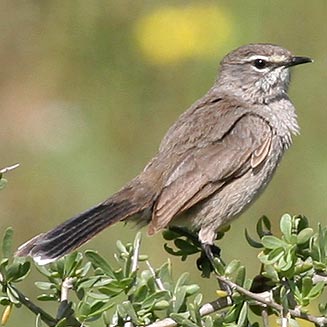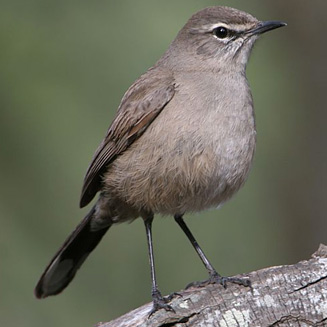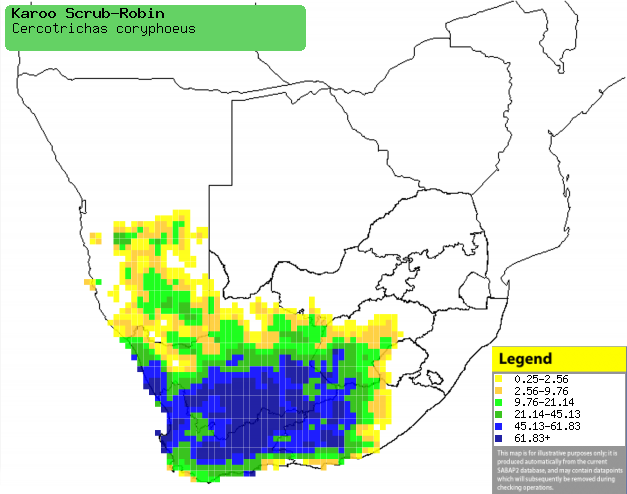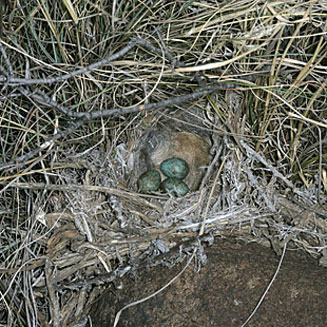|
Cercotrichas coryphoeus (Karoo
scrub-robin)
[= Erythropygia coryphaeus]
Slangverklikker
[Afrikaans]; Agrobate coryphée [French]; Karruheckensänger [German];
Rouxinol-do-mato do Karoo [Portuguese]
Life > Eukaryotes > Opisthokonta > Metazoa (animals) > Bilateria > Deuterostomia > Chordata > Craniata > Vertebrata (vertebrates) > Gnathostomata (jawed vertebrates) > Teleostomi (teleost fish) > Osteichthyes (bony fish) > Class: Sarcopterygii (lobe-finned fish) > Stegocephalia (terrestrial vertebrates) > Tetrapoda (four-legged vertebrates) > Reptiliomorpha > Amniota > Reptilia (reptiles) > Romeriida > Diapsida > Archosauromorpha > Archosauria > Dinosauria (dinosaurs) > Saurischia > Theropoda (bipedal predatory dinosaurs) > Coelurosauria > Maniraptora > Aves (birds) > Order: Passeriformes > Family: Muscicapidae > Genus: Cercotrichas
 |
 |
| Karoo scrub-robin, West Coast Fossil Park, Western Cape, South Africa. [photo H. Robertson,
Iziko ©] |
Karoo scrub-robin, Greyton, South Africa. [photo
Trevor Hardaker ©] |
Distribution and habitat
Endemic to southern Africa, occurring from southern Namibia
to much of the Northern, Western and Eastern Cape, extending into the Free
State, Lesotho and the North-West Province. It generally prefers dry scrub with
patches of bare ground, such as renosterveld, Karoo shrubland, fynbos, bushveld
and drainage line woodland dominated by either Sweet thorn (Acacia karroo)
or Wild tamarisk (Tamarix usneoides). It is also common in vegetation
along dam walls and gardens of ram homesteads, and it may even forage on beaches
in the intertidal zone.
|
 |
|
Distribution of Karoo scrub-robin in southern Africa,
based on statistical smoothing of the records from first SA Bird Atlas
Project (©
Animal Demography unit, University of
Cape Town; smoothing by Birgit Erni and Francesca Little). Colours range
from dark blue (most common) through to yellow (least common).
See here for the latest distribution
from the SABAP2. |
Brood parasites
It has been recorded as host of the
Diderick
cuckoo.
Food
It mainly eats insects, especially ants, termites and
beetles, doing the most of its foraging on bare ground. The following food items have been recorded
in its diet:
- Insects
-
Hymenoptera
- wasps
- bees
- ants
- Lepisioita
- Anoplolepis
- Campanotus
- Crematogaster
- Dorylus
- Linepithema humile (Argentine ants
- Meranoplus
- Messor
- Monomorium
- Ocymyrmex
- Pheidole
- Solenopsis
- Technomyrmex
- Tetramorium
-
termites, especially Microhodotermes viator (Southern harvester
termite)
- Coleoptera
(beetles)
- caterpillars and moths (Lepidoptera)
- grasshoppers (Orthoptera)
- plant bugs (Hemiptera)
- flies and their larvae (Diptera)
-
Spiders
- Fruit
- Rhus (currants)
- Lycium (honey-thorns)
- Atriplex semibaccata (Creeping saltbrush)
Breeding
- Monogamous facultative cooperative breeder, as the roughly 10 week
juveniles help their parents with rearing the next brood.
- The nest (see image below) is an open cup set into a platform of large
twigs, usually with a ramp of sticks protruding from one side of the
structure, lined with fine material such as dry grass, leaf fragments, dried
flowerheads, moss, sheep or goat hair and the fur of hares and small
rodents. The sticks are often to large for it to carry in flight, so instead
it drags them along ground, the whole nest construction process taking about
5-6 days in total. The female often builds it by herself, but the male and
group members often feed her and help collect nesting material. It is
typically placed at the base or in the foliage of a small shrub, in a recess
of a gully bank or in a man-made object such as an old tin.
 |
|
|
Karoo scrub-robin nest with eggs, Springfontein,
South Africa. [photo Warwick Tarboton ©] |
|
- Egg-laying season is from July-December, peaking around October.
- It lays 2-4 eggs, which are incubated solely by the female for about
13-15 days, while the male regularly feeds her.
- The chicks are fed by both adults and sometimes their helpers, leaving
the nest after about 13-17 days. They typically remain in the nest bush for
a 1 or 2 more days before taking off, becoming fully independent after about
4 more weeks, but sometimes remaining with the parents to help with next
brood.
Threats
Not threatened.
References
-
Hockey PAR, Dean WRJ and Ryan PG 2005. Roberts
- Birds of southern Africa, VIIth ed. The Trustees of the John Voelcker
Bird Book Fund, Cape Town.
|
